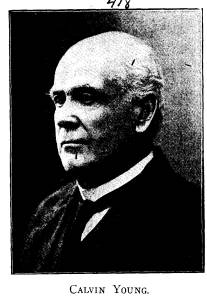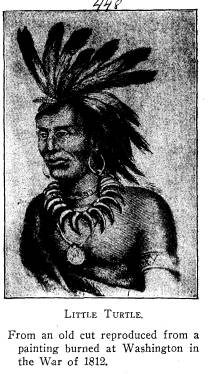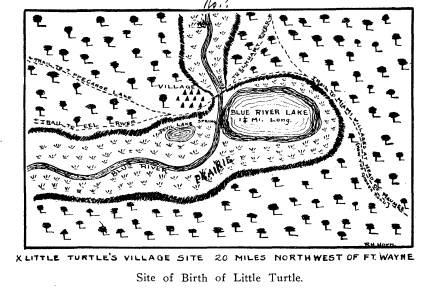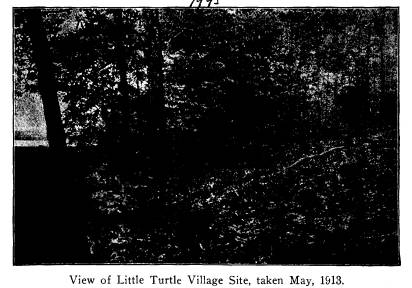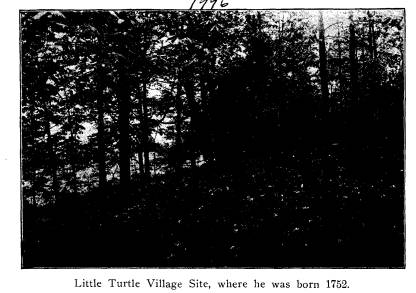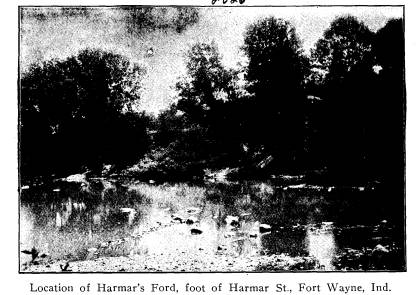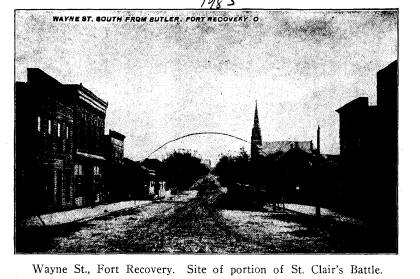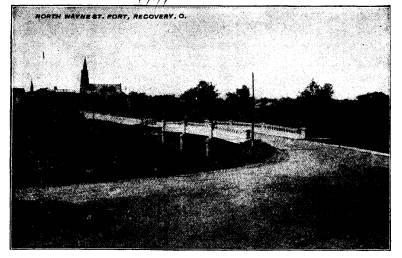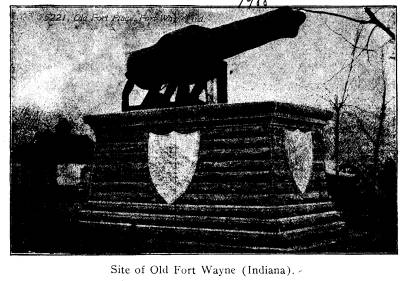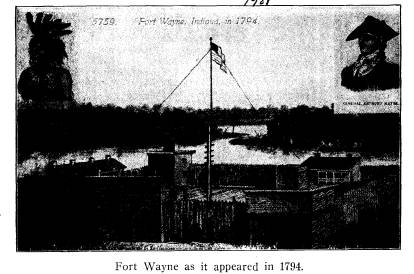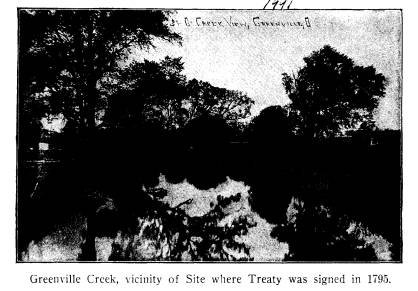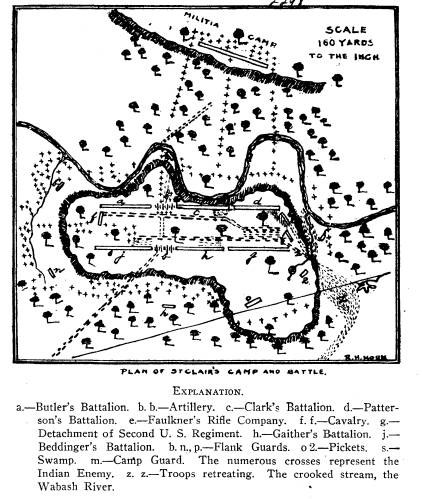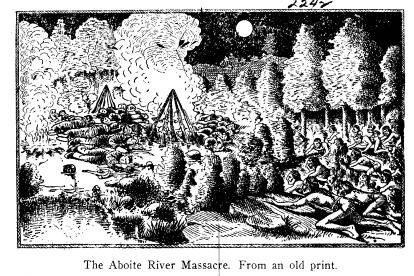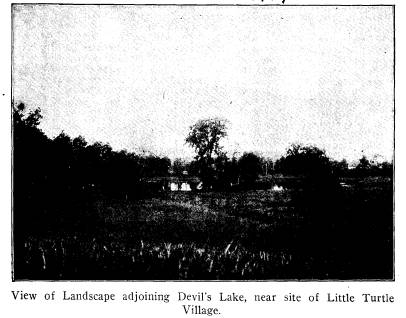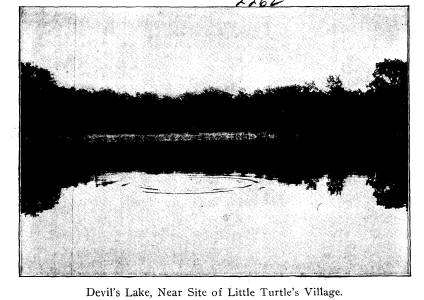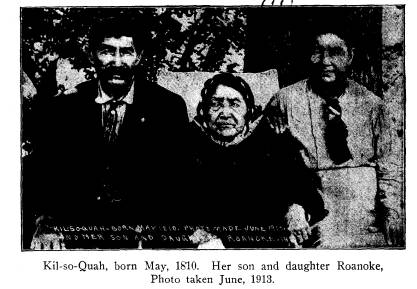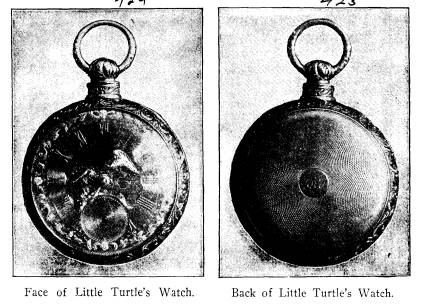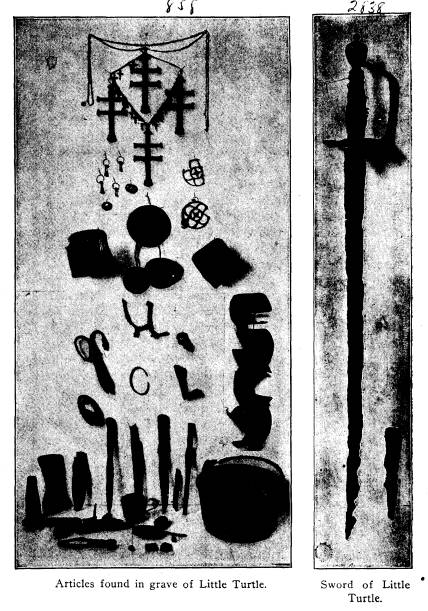Ohio History Journal
|
THE BIRTHPLACE OF LITTLE TURTLE.
BY CALVIN YOUNG. It may not be improper to acquaint the reader with what is to be found in the following pages, -the design of which is to add some new facts to the history of Little Turtle, a dis- tinguished Chieftain of the Miami tribe; to portray some new historical sidelights that have heretofore never been published and to revise and enlarge on a former article written by myself |
|
|
|
of North American Indians," E. A. Allen's "History of Civiliza- tion," F. E. Wilson's "Peace of Mad Anthony" and possibly some other authors. To all of which we make respectful ac- knowledgments. We especially owe a debt of gratitude to Mr. J. M. Stouder (105) |
106 Ohio Arch. and Hist.
Society Publications.
of Fort Wayne, Indiana, to F. E. Wilson
of Greenville, Ohio,
and to Mr. C. K. Lucas of Huntington,
Indiana, for courteous
favors rendered and for valuable
suggestions. We also wish to
say we have made every effort possible
in this sketch to lay
before the reader nothing but the most
reliable record of facts
to be found anywhere. To make this work
reliable, readable
and entertaining has been the cherished
object of the author.
We respectfully dedicate the following
pages to the young
and rising generation, and to every
true-born American who
desires more perfect knowledge of the
greatest Indian Chieftain
that ever appeared in the annals of
American History. Cicero
said, "Not to know what happened
before we were born is to
remain always a child. For what were the
life of man did we
not combine present events with the
recollection of past ages ?"
Consequently future generations will
hold us responsible if we
fail to honestly and faithfully preserve
the records of pioneer
times.
Our children should be taught the spirit of genuine
patriotism through a correct knowledge
of the sufferings and
hardships of our pioneer fathers and
mothers in the early settle-
ment of our country.
E. A. Allen, in his "History of
Civilization", tells us, that
the American Indians, their ancestors
and kindred tribes be-
longed to the Turanian race. Other writers term them
the
Mongoloid family, and some eminent men
of science tell us
there is strong evidence that there have
been three distinct
creations of the human race at different
periods of the world's
history, and each at different
locations, viz. the African, or
Black Race, which made its appearance on
the east coast of
Africa; the Yellow, or Turanian Race,
which belongs to America
and are indigenous to the American soil;
the Aryan, or White
Race, which first made its appearance in
northern Europe, or in
Central Asia. However, we take it for
granted that the Amer-
ican Indian has been a bona fide
resident of the wilds of
America for untold centuries.
The echo of the red man's voice
Resounded through the vale,
It lingered on the evening air,
It floated on the evening gale.
The Birthplace of Little Turtle. 107
It was borne along the mountain side,
It drifted through the glen;
It died away among the hills,
Far from the haunts of men.
His face was flushed with hues of
health,
His arms and feet were bare;
He had a lithe and active form,
A scalp of raven hair.
Behind the hills he passed from sight,
A sunken, fallen star;
Until his voice is faintly heard
Still calling from afar.
The Miami Indians belonged to the great
Algonquin family
with whom every student of American
ethnology is quite fa-
miliar. The first account we have of the
Miami Indians was
by the French who found them in 1658, at
Green Bay, Wis-
consin; other branches of the tribe
lived still later in north-
eastern Illinois, northern Indiana and
northwestern Ohio. It
seems from these locations that they had
gradually moved south-
east until they possessed the entire
western part of Ohio as far
south as the Ohio river, and east to the
Scioto river, giving their
name to three rivers, and to one county
each in Ohio and In-
diana. Of the entire Algonquin family
there were perhaps none
more stable, heroic and resolute than
this Miami tribe. In
stature, for the most part, the Miamis
were of medium height.
well built, with heads rather round than
oblong. Their counte-
nances were agreeable rather than sedate
or morose; swift on
foot and excessively fond of racing,
both on foot and horse.
Little Turtle was six feet high, slender
and muscular. He
had complete control of himself at all
times, could smile in the
depth of anger, was able, fluent,
earnest and logical in speech, a
cunning and adroit diplomat and was
remarkably dignified in
appearance.
Colonel John Johnson, Indian agent,
says, "Little Turtle was
a man of wit, humor and veracity, fond
of the company of gentle-
men and delighted in sumptuous meals and
good eating." A
writer quoted by Mr. Drake says,
"He saw Little Turtle soon
after St. Clair's defeat at Montreal and
also described him as
|
108 Ohio Arch. and Hist. Society Publications. about six feet high, sour and morose, and apparently crafty and subtle." The Mohicans were also a branch of the Algonquin family, and first known to the English and Dutch occupying both banks of the upper Hudson river in New York, and the territory as far east as the Connecticut valley, also extending north almost |
|
|
|
The village where Little Turtle was born in 1752 was located on the north tributary of Eel river, twenty miles north- west of Fort Wayne, Whitley County, Indiana, on lands now owned by William Anderson, in Section 9, Smith Township. This north tributary is known today as the Blue river branch near its junction at the Blue River Lake, to which it furnishes an outlet only a short distance away. The village stood on the west side of the river on a high, sandy point of land, surrounded |
The Birthplace of Little Turtle. 109
on three sides by a great bend in the
river. A wide prairie
marsh skirted these high lands north and
south, but on the east
the high banks were near each other,
making it an easy ford
to the north bank of the lake, only a
few hundred yards to the
eastward. The Blue Lake covered possibly
five hundred acres.
Near the foot of the hill immediate to
the south a fine spring
of water bubbled forth underneath the
shade of a beautiful grove
of large oak trees. A short distance to
the south of the spring,
nestling in the middle of the prairie,
was a small lake containing
three or four acres, and so very deep
that the water looked a
dark blue. It was called by the Indians
Devil's Lake from the
fact that something mysterious had
appeared in or near it, en-
tirely unknown to Indian lore, during a
dusky summer evening,
at which the Indians became terribly
frightened and ran all the
way to Fort Wayne, then a frontier
outpost.
Many times, about 1863, and for a number
of years later,
the writer was on this peculiar ancient
village site, where Little
Turtle was born, and where he spent
nearly all his life. This
always seemed to me like enchanted
ground. I have heard the
solemn bark of the lonesome fox, the
weird scream of the
Canada lynx, also the shrill notes of
the great northern loon
as he floated by high in the clear blue
atmosphere. Along the
river banks were Indian trails worn
several inches deep, which
not only spoke of primitive, but also of
recent times, as it was a
flourishing village in 1812 and possibly was
not entirely de-
serted until 1846, at which time the
Indians were nearly all re-
moved to the west. Numerous burial
places in the vicinity could
still be located as late as 1856, in
which the consecrated dead
had been enclosed in pole pens as a
temporary protection to
the body. A catlinite peace pipe was
found in 1884, by Mary
(Gross) Boggs, on the surface of a
near-by field. A valuable
cache of flint implements was plowed out
a short distance down
the river a few years ago, which fell
into the hands of careless
parties, and were soon lost or
destroyed. Some very fine slate
ornaments, tube whistles, and other
similar objects were found
recently near Coulter Lake, a mile
below.
The site of this village is still
uncleared, and, no doubt,
contains many hidden and curious remains
of prehistoric times.
|
110 Ohio Arch. and Hist. Society Publications. An Indian trail led from this village northwest to the Elkhart river; another, southeast to the Miami villages, at the head of the Maumee (now Fort Wayne); a third, southwest down Eel river and the Wabash, and still another almost due west to Tippecanoe Lake and the Kankakee river. Blue River Lake is only a short distance and in plain view to the southeast. No doubt Little Turtle as a child and youth spent many happy hours about this enchanted spot. On this account the reader will pardon us if we make a slight digression |
|
|
|
in describing more fully the lakes of northern Indiana. We can do no better at this point than to quote from Prof. W. S. Blatchley, above mentioned: "The lakes of northern Indiana are the brightest gems in the corona of the state. They are the most beautiful and expressive features of the landscape in the region wherein they abound. Numbered by hundreds they range in size from an area of half an acre up to five or six square miles. With the fertile soil, the great beds of gravel and myriads of boulders, large and small, they are to be classed as mementoes of the mighty ice sheets, which in the misty past covered the |
The Birthplace of Little Turtle. 111
northern two-thirds of the state.
Outside of the counties in
which they occur but few of the citizens
of Indiana know of
their presence, their beauty and their
value. Their origin, their
fauna and flora, the causes of their
gradual diminution in size
and final extinction are likewise known
by but few.
"By the red man these lakes were
more highly appreciated
than by his more civilized Caucasian
successor, for the reason
that the Indian stood much nearer to
wild nature than we. On
the higher ridges overlooking these
lakes he had his village sites.
Over their placid waters he paddled his
birch-bark canoe and
from their depths he secured with hook
and spear fishes suf-
ficient to supply his needs, while
mussels and the roots of the
water lilies added variety to his daily
food, while fowls by
myriads in their migrating seasons came
and went, stopping to
feed upon the lakes, thus offering him
many a chance to test
his marksmanship with bow and arrow,
while the skins of the
muskrat, otter, and beaver, which he
trapped about the marshy
margins, furnished him protection
against the cold. Thus it
will be seen that his very existence
depended often times upon
these living bodies of water.
"It is little wonder, therefore,
that he remained in their
vicinity until driven westward by the
conquering white man,
leaving only the signs of his
feasts-vast piles of shells, bones,
and pit ovens - as reminders of his
former presence and former
glory."
Blue River Lake lies two miles northwest
of Cherubusco,
and is in Sections 9, 1O, 15 and 16,
Smith Township of Whitley
County, Indiana. It is oblong in shape,
narrower at the eastern
end, is about one and one-quarter miles
long by one-half mile
in average width. It has an area of
about 420 to 500 acres, and
a very uniform depth of 40 to 60 feet.
The area of shallow water
is of medium width, rather broad on the
east, south and west
sides, and narrower on the north. The
shores at most points are
rather abrupt, the surrounding country
being of a rolling type.
Blue river heads in Green township,
Noble county, from a
chain of small lakes that range across
the north side of the town-
ship, including Sand, Long, Dock and
Bowen Lakes. It finally
empties into Blue River Lake for a few
rods only on the west
112
Ohio Arch. and Hist. Society Publications.
end, and then takes a southwest course
by Columbia City, and
a few miles below empties into Eel
river. This lake thus re-
ceives its waters from upper Blue river
and from springs along
its sides and bottom. It is well stocked
with food fishes.
Dr. Dryer speaks of the midsummer
vegetation about the
shores of this lake as follows:
"Aquatic vegetation in great
variety and profusion furnishes a
botanist paradise. There are
pond weeds, water shield, bladder wort,
yellow pond lilies, duck
weed, cat-tail, pickerel weed, smart
weed, and numerous other
varieties."
This lake is the only locality in
northeastern Indiana known
to the writer where the famous and
splendid American lotus
occurs. Here it is as abundant as the
white water lily. Its
flowers are difficult to procure because
they are gathered by
numerous visitors as fast as they open.
With their leaves rolled
up, and rocking like a boat, or expanded
into an orbicular shield
20 or 30 inches in diameter and flapping in the wind, they pre-
sent an interesting and attractive
sight. The water in Blue
River Lake in midsummer has the
appearance of muddy coffee,
and through the Whole season teems with
plant and animal life.
Such a lake as this would repay a
thorough and prolonged
biological examination, and would
furnish the naturalist with
material enough for several years study.
Tippecanoe Lake, the head of Tippecanoe
river, lays to the
westward, possibly sixteen miles, and
reaches the remarkable
depth of 125 feet. It seemed that nature had
provided here with
a lavish hand an ideal home for the red
man. The soil was
productive for Indian corn, and the
writer saw the old Indian
fields red with strawberries in June.
Wild grapes, wild plums,
hazel-nut bushes, acorns and wild
berries of all kinds grew near
by in abundance. There were red deer,
wild turkeys, prairie
chickens and pheasants, river and lakes
teeming with fish, and,
over all a scenic beauty that the poet
with his pen could not
describe nor the artist with brush
portray. All the beauty and
poetry of Indian lore, it seems, were
represented here as the
floating clouds of summer long ago
drifted o'er the deep blue
sky. Such was the birthplace and home of
Little Turtle, the
great Miami chieftain.
The Birthplace of Little Turtle. 113
In order to identify this location as
Little Turtle's village,
and if possible to leave no doubt in the
mind of the future student
of history, I will state here that this
site is just twenty miles
northwest of Fort Wayne, which agrees in
distance with the very
best authorities on the subject now in
hand. We refer the reader
to the "Hand Book of the North
American Indians," "Bulletin
30", Vol. I, page 771, published by
the Bureau of American
Ethnology, Dillon's "History of the
State of Indiana", page 495,
also to Bryce's "History of Fort
Wayne", published in 1868,
page 227.
A little over two months after Little
Turtle's death, which
occurred at Fort Wayne, July 14th, 1812,
General Harrison
ordered Colonel Simrall, on September 17th
following, to destroy
Little Turtle's village twenty miles
northwest of Fort Wayne,
but not to destroy Little Turtle's house
built by the government
for him. This dwelling consisted of a
substantial log house about
eighteen by twenty feet square. The
personal examination of
those grounds, and the village site
fifty years ago, and the settle-
ment of the early settlers at that time,
when the Indians were
still present, fully corroborate the
statement herein made. An
especially good witness was Mr. Robert
Walburn, an old trapper
and hunter, who killed the last red deer
known to run wild in
Whitley County, in 1870. This gentleman
informed the writer
of the above-stated facts.
One of the first settlers of Smith
township, Whitley County,
was one Mr. Martin, who arrived with his
family about 1840.
His cabin stood within three or four
miles of this village. He
had a son, Hiram, who several times
narrowly escaped from the
wolves. The Miami Indians were still
there at that time. The
writer knew this man after he had
reached middle life, and
enjoyed many interesting talks with him
about the wild animals,
and Indians, who were still there in his
boyhood days. His
memory was very clear and accurate
concerning the old village.
The main branch of Eel river is crossed
by the old Indian
trail (now the Goshen road) only eleven
miles northwest of
Fort Wayne. This could not have been the
stream on which
this village was located, as that stream
was twenty miles from
old Fort Wayne, or nine miles beyond the
above point.
8-Vol. XXIII.
|
114 Ohio Arch. and Hist. Society Publications. The Miami villages at the head of the Miamis were then called by their Indian name Ke-ki-on-ga, signifying in English "blackberry patch." As previously stated, Little Turtle's father was a Miami chief, and his mother was a Mohican. According to Indian custom; he was a Mohican, and received no advantage from his father's rank. Consequently, he was not a chief by descent. However, his talents having attracted the notice of his fellow tribesmen, he was made chief of the Miami's while com- paratively a young man. When twenty-four years of age we |
|
|
|
hear of him with Burgoyne advancing from the north in his dis- astrous campaign against Saratoga, where he finally surrendered to General Gates, October 17th, 1777. During the summer of 1780 we find the gallant and unfortu- nate LaBalm, a native Frenchman, who had sailed the year pre- vious from France with LaFayette, at Kaskaskia and later at Vincennes. Here he recruited fifty or sixty men, and in the fall of the same year proceeded up the Wabash on his adventure against the trading post of Kekionga. The sudden appearance of a foe unknown as to character, numbers and designs, threw the |
The Birthplace of Little Turtle. 115
Indians into great alarm and caused them
to flee in all directions.
After remaining a short time and making
plunder of the goods
of some of the traders and Indians, he
retired to near the Aboite
creek, a tributary from the west into
Little river, eight miles
southwest of Fort Wayne, where he
encamped. These traders,
having invited the Indians to follow and
attack LaBalm, soon
rallied the warriors of the village and
vicinity under the lead of
their war chief, the Little Turtle, and
falling upon them in the
night massacred the entire party. Not
one is said to have sur-
vived to relate the sad story of the
expedition. It seems that
Little Turtle's time was employed during
the decade immediately
following 1780, as a leader in
various war expeditions against
different parts of the frontier,
especially Ohio river points, and
the outposts of Kentucky.
In one of these expeditions to Kentucky
he captured a boy
about eleven years old by the name of
William Wells, whom he
adopted. Wells grew up to manhood and
became a favorite of
Little Turtle and wife. In time he won
and married his adopted
sister, Little Turtle's beautiful
daughter, and thus became in fact
the son-in-law of Little Turtle. He also became a valuable
interpreter on numerous occasions
between the Indians and
whites. Little Turtle had another
daughter who married a chief-
tain by the name of Wak-shin-gah, and
became the mother of
Kil-so-quah. The latter now resides near
Roanoke, Huntington
County, Indiana, on a little farm with
her son and daughter.
She was 103 years old last May, and is the last full-blood Indian
in the northwest living in the Wabash or
Maumee valleys.
The first permanent settlement of the
Northwest Territory
was on the seventh of April, 1788, at
Marietta, by General Rufus
Putnam, composed of forty-seven person.
A certain rivalry
existed between two gentlemen as to who
should cut down the
first tree upon landing at Marietta.
Captain Daniel Davis by
accident selected a buckeye tree, and
the other person a beech.
Mr. Davis felled his tree first on
account of its soft wood. Con-
sequently Ohio was called from this
incident the "Buckeye State."
Cincinnati was settled on December 28th,
1788. This year was
famous in the history of western
emigration, as no less than
twenty thousand persons, men, women and
children, passed the
|
116 Ohio Arch. and Hist. Society Publications. mouth of the Muskingum during the season on their journey down the Ohio river. In a very short time a territorial govern- ment was established, with General Arthur St. Clair as Governor. The treaty of Paris in 1783, following the American Revo- lutionary War, did not bring peace with the Indian tribes of the northwest. The British, meanwhile, kept on good terms with the Indians, intrigued with them, and encouraged them in their hostilities against the Americans, which continued with savage fury. Murderous incursions by the Miamis and confederated |
|
|
|
tribes from the Maumee and western countries were frequently attended with savage cruelties. The government decided upon immediate aggressive movements. To delay was only to encour- age the Indians in their obstinacy, and the British in their unscrupulous work of feeding, clothing and equipping the Indians for their depredatory incursions against the Americans. The first army in this Indian war organized by the general government was placed under command of General Josiah Harmar. His arrangements being completed, he left Fort Wash- ington September 30th, 1790, with 320 regulars and 1,133 militia |
The Birthplace of Little Turtle. 117
and drafted men, making in all 1,453
men. General Harmar
arrived at the Miami villages October 17th,
and found them all
deserted. He proceeded immediately to
burn them and destroyed
20,000 bushels of corn. The 18th was
spent in a fruitless attempt
to locate the Indians. On the 19th
Colonel Hardin led a detach-
ment of three hundred men including a
small number of regulars.
They followed along an Indian trail to
the northwest for about
fifteen miles, or to within one mile of
the present village of
Cherubusco, and to within five miles of
Little Turtle's famous
village. Through the neglect of Colonel
Hardin to give the com-
mand to move forward Falknor's company
was left in the rear,
possibly a mile or more. The absence of
Falknor at the time
became apparent. Major Fontaine, with a
portion of the cavalry,
was at once sent in pursuit of him with
the supposition that he
was lost. At this time the report of a
gun in front of the detach-
ment fell upon the attentive ear of
Captain Armstrong in com-
mand of the regulars. When Armstrong
informed Colonel
Hardin that the fires of the Indians had
been discerned the latter
believed that the Indians would not
fight and rode in front of
the advancing columns. The detachment
was soon fired on from
an ambuscade both skilfully designed and
vigorously executed
by the skill and genius of the
commanding Miami chief, Little
Turtle, at the head of not more than one
hundred and fifty war-
riors. The Indians on this occasion
gained a complete victory,
having killed nearly 100 men. The rout
of Colonel Hardin and
Captain Armstrong continued until they
arrived that evening at
the camp of General Harmar. Little
Turtle still recruited his
Indian army and slowly followed the
trail to near Harmar's
encampment, which was still located at
the old Miami village site,
at the head of the Maumee. On the
evening of the twenty-first
of October at 10 o'clock General Harmar
left camp and started
on his return to Fort Washington. Little
Turtle, who was im-
mediately apprised of this fact, was in
possession of the old
Miami village early on the morning of
the 22nd. Colonel Hardin,
surmising that the Indians had returned
to the burned village,
solicited General Harmar to let him
return and inflict a more
severe chastisement upon them. The
request was granted and
Colonel Hardin with Major Wyllys was
sent back with a detach-
|
118 Ohio Arch. and Hist. Society Publications. ment of 400 men. They too soon became entangled in the snares of the wily Little Turtle, who, on the point of land between the St. Joseph and the Maumee, inflicted another serious defeat to the American arms. Majors Hall and Fontaine, with a detach- ment of militia was to pass around the village at the head of the Maumee, cross the St. Mary's and the St. Joseph, gain the rear of the Indian encampment unobserved and await an attack by the main body of the troops in front. Those consisting of Major M. Mullins' battalion, and the regulars under Major Wyllys were |
|
|
|
to cross the Maumee at the usual ford and thus surround the savages. The game was spoiled by the imprudence of Major Hall, who fired prematurely upon a solitary Indian and alarmed the encampment. The startled Miamis were instantly seen flying in different directions. The militia under Major Hall and the cavalry under Fontaine, who had crossed the river, started in pursuit in disobedience of orders, leaving the regulars under Wyllys, who had also crossed the Maumee, unsupported. The latter was attacked by Little Turtle and the main body of the Indians, and driven back with great slaughter. |
The Birthplace of Little Turtle. 119
Richardville, a half-blood about 10 or 12 years of age,
was
in the battle, and in later life often
asserted that he could have
crossed the stream upon the bodies
dryshod. This man suc-
ceeded Little Turtle as Chief, and died
at Fort Wayne in 1840.
The above statement is from Lossing
(Field Book of the War
of 1812), who visited Fort Wayne in
1860. We also have an-
other statement by this same
Richardville taken from Bryce's
"History of Fort Wayne." His
recollection of the way the In-
dians stole along the bank of the river
near the point long since
known as Harmar's ford, was most
thrilling. Not a man among
the Indians, said he, was to fire a gun
until the white warriors
under Harmar had gained the stream and
were about to cross.
Then the red men in the bushes, with
rifles leveled and ready
for action, just as the detachment of
Harmar began to near the
center of the Maumee opened a sudden and
deadly fire in the
stream, until the river was literally
strewn from bank to bank
with the slain, one upon the other, both
horses and men, and the
water ran red with blood. While this was
going on at the ford,
Majors Hall and Fontaine were
skirmishing with parties of In-
dians a short distance up the St.
Joseph. Fontaine, with a num-
ber of his followers, fell at the head
of his mounted militia in
making a charge. He was shot dead, and
as he fell from his
horse was immediately scalped. The remainder, with those
under Hall and Fontaine, fell back in
confusion toward the
ford of the Maumee and followed the
remnant of the regulars
in their retreat. The Indians, who
suffered a heavy loss, did
not pursue. General Harmar at about this
time, it seems, had
lost all confidence in the militia and
decided to return to Fort
Washington at once. A considerable
number of the regulars of
General Harmar's army had followed
Washington and other
generals in the war of the Revolution.
The slain of this little army were buried
in the low bank
near the ford of the Maumee, on the
present site of Fort Wayne,
Indiana.
The writer recently viewed the location
of Harmar's ford,
which lies at the foot of Harmar Street,
Fort Wayne, Ind. It
shows no sign of blood and carnage
today. General Harmar
was forced to struggle homeward to Fort
Washington as best
|
120 Ohio Arch. and Hist. Society Publications. he could, a greatly disappointed commander. It was indeed a dreary march. Notwithstanding the loss that the Indians had suffered they became more angry than ever. All the western tribes made common cause with the Miamis and banded together in more open warfare, so that the settlers were kept in constant fear of the tomahawk and scalping knife. It may be mentioned here that in the spring of 1791 the President appointed Governor St. Clair Major General, and placed him in command of the army in place of General Harmar, |
|
|
|
form a great confederacy among the western tribes, together with Blue Jacket, the great chief of the Shawanese, and Buckonga- halas, chief of the Delawares, with other northwestern savages, whose object was to drive the white settlers beyond the Ohio river. These Chiefs, in combination with Girty, McKee and Elliott, and other renegades, headed a band of warriors whose discipline had probably never been equaled in Indian warfare. |
The Birthplace of Little Turtle. 121
Nothing but a decisive blow by a large
and well-organized force
could quell the uprising being now
formulated by their leaders.
The poet well describes the situation at
this time when he
says:
"They rise by stream and yellow
shore,
By meadow, moor and fen;
By weedy rock and torrents' roar
And lonesome forest glen.
"From many a weedy, moss-grown
mound
Start forth a war worn band.
As when of old they caught the sound
Of hostile arms and closed around
To guard their native land."
The Indians, at the instigation of the
British, contended for
the Ohio river as the boundary of the
United States. To get
control of the upper lakes, and the
valuable fur trade around
them, was a favorite scheme of the
British statesmen. It was
even proposed as a sine qua non at the
time, by the British com-
missioners who negotiated the Treaty of
Peace in 1814, that
the Indians inhabiting that portion of
the United States within
the limits established by the Treaty of
1783, should be included
as the allies of Great Britain in the
projected pacification, and
that the boundaries be settled for the
Indian territory upon a
basis which would have operated to
surrender to a number of
Indians, not to exceed a few thousand,
the right of sovereignty
as well as of soil over nearly one-third
of the territorial dominion
of the United States, inhabited by more
than one hundred thou-
sand of its citizens.
When the British left Fort George, at
the foot of Broad-
way, New York, November 25th, 1783, they
left their flag fly-
ing. It was believed that the absence of
British authority in
the United States would be only
temporary, hence the continua-
tion of the Indian wars in the northwest
at their behest. The
final war of 1812 is justly termed the
second war for American
Independence. The second war gave to
every true-born Amer-
ican an idea of absolute independence
forever from British
thraldom.
It seems that Little Turtle was watching
with an eagle's
|
122 Ohio Arch. and Hist. Society Publications. eye for another opportunity to strike the American army. The coming victory over St. Clair was clearly the result not of over- whelming numbers, but of superior generalship. Here on the banks of the Wabash about daylight on the morning of Novem- ber 4th, 1791, Little Turtle assailed St. Clair's army in front, on both flanks, and also at the rear near the close of the action, which was about half-past nine o'clock in the morning. At this time it became necessary to make a charge in order to clear the way to the road, so as to permit the retreat of the remnant of |
|
|
|
the army, which was hurled headlong down the trail, southward for a distance of three or four miles, with terrible slaughter by the victorious and triumphant Indian warriors. No such defeat had heretofore occurred in American his- tory, not even that of General Braddock in 1775. Down to the present time it has only been surpassed once, the disastrous de- feat of General Custer on the Big Horn, June 25th, 1876. St. Clair's defeat was described by one Mr. Thomas Irwin in a diary which he kept at the time. He was a wagoner in St. Clair's army. He says, "That battle always reminded him of a |
The Birthplace of Little Turtle. 123
furious thunder storm that comes up
quick and rapidly, and
soon disappears, leaving havoc and
desolation in its path."
The escape of Stephen Littell was
remarkable. At the
commencement of the battle he was in the
extreme advance.
Being unable to keep up with his
comrades in their precipitate
flight, he sprang aside and hid in a
dense thicket as the yell-
ing savages rushed by in hot pursuit.
Here he remained some
time in dreadful suspense as the roar of
the battle died away
in the distance, the Indians being in
full chase of the flying
army. He then ventured slowly forward
until he reached the
scene of the night's encampment. Awful
was the scene pre-
sented to him there, the bodies of some
seven hundred of the
killed and wounded encumbering the
ground for the space of
about three hundred and fifty yards. It
was a cold, frosty
morning. The scalped heads presented a
very revolting spectacle.
A peculiar vapor or steam ascended from
them all. Many of
these poor creatures were still alive,
and groans were heard on
all sides. Several of the wounded,
knowing that as soon as the
savages returned they would be doomed to
death by torture,
implored young Littell to put an end to
their misery. This he
refused to do. Being anxious as to the
fate of his father, and
seeing among the dead one who bore a
strong resemblance to
him, he was in the act of turning over
the body to examine
the features when the exultant and
terrific shouts of the re-
turning savages fell upon his ear, and
already he could see
through the forest the plumed warriors
rushing back. It so
chanced that an evergreen tree of very
dense foliage had been
felled near where he stood. It was his
only possible covert. He
sprang into the tree and turned its
branches as well he could
around him. Scarcely had he done this
when the savages came
bounding upon the ground like so many
demons. Immediately
they commenced their fiend-like acts of
torture upon all the
wounded. The scenes he continued to
witness were more awful
than the imagination could possibly
conceive. Here our sub-
ject remained until a suitable time
arrived for him to make his
escape, which he did-the only one left
to tell the sad story
of the awful battlefield.
|
124 Ohio Arch. and Hist. Society Publications. In justice to General Arthur St. Clair, the commanding officer of the army on November 4th, 1791, I will say that a committee was appointed by the House of Representatives to inquire into the cause of the disaster that fatal day. The con- clusion of this committee, after the most patient and careful in- vestigation, was that the defeat was due chiefly to the gross and various mismanagement of others and should in nowise be im- puted to the commander-in-chief. With his dismissal from office as governor of the North- west Territory, November 22nd, 1802, the public life of Major |
|
|
|
General St. Clair terminated. Broken in health and fortune, he now returned, at the age of sixty-eight, after a life spent largely in the service of his adopted country, to the Ligonier valley, western Pennsylvania. He had never been reimbursed by his government for the private means spent by him during the war of the Revolution. In addition to this, during the Indian campaign in 1791, he had again advanced his personal credit to the public service, and the officers of the government, for more or less technical reasons, now and thereafter turned a deaf ear to his appeals for reim- bursement or succor. He struggled earnestly from year to year |
The Birthplace of Little Turtle. 125
to retrieve his broken fortunes, but
when the years of the em-
bargo came, and the values of all
property in America suffered
such terrible depreciation, he was
compelled to stand by and see
the last of his property, real and
personal, sold by the sheriff,
and himself left at nearly eighty years
of age absolutely penni-
less, dependent upon the charity of his
family and friends. In
referring to this execution St. Clair
himself wrote, "They left
me a few books of my classical library,
and the bust of John
Paul Jones, which he sent me from Europe
for which I was
very grateful."
One of his sons built him a log cabin on
a small piece of
land on Chestnut Ridge, five miles west
of Ligonier. Here he
lived in honorable poverty until August
31st, 1818, when he
died from the effects of an injury
sustained in being thrown
from a wagon while driving to town.
Thus this hero of two wars, and of
countless deeds of faith-
fulness, bravery and self-denial in
times of peace, was quietly
interred in the little burying ground of
the neighboring hamlet
of Greensburg, Pennsylvania.
By a strange and sad coincidence General
Clark, conqueror
of the Great Northwest, and General St.
Clair were both per-
mitted to die in poverty, neglect and
obscurity. Both met a
similar fate at about the same age and
in the same year.
The language of the epitaph upon the
simple stone which
was afterwards erected at the grave of
St. Clair by his Masonic
brethren has often been quoted and
should still carry its earnest
appeal to men of our time. It is as
follows:
"The earthly remains of Major
General Arthur St. Clair
are deposited beneath this humble
monument which is erected
to supply the place of a nobler one due
from his country."
It was nearly a year before the general
government made
another attempt for the conquest of the
northwestern tribes,
who, it seems, had so far been
invincible in spite of all the ef-
forts brought to bear upon them.
The next commander-in-chief of the
American army to ap-
pear upon the arena of western warfare
was General Anthony
Wayne, who arrived at Fort Washington in
April, 1793, with
a well-organized army of some twenty-six
hundred troops.
126
Ohio Arch. and Hist. Society Publications.
On the 13th of October, 1793, General
Wayne arrived on
the present site of Greenville, Ohio, at
which location he built a
fort and remained until July 28th, 1794.
On October 17th, just four
days after Wayne arrived at
Greenville, Little Turtle made a dash on
a baggage and provision
train on the trail seven miles north of
Fort St. Clair (now
Eaton, Ohio). The convoys were under
command of Lieu-
tenant Lowry, and Ensign Boyd, and were
loaded with supplies
and provisions for the army. In the
affray which followed
thirteen noncommissioned officers and
privates were killed, in-
cluding Lieutenant Lowry, and seventy
pack horses were killed
or driven away.
This incident shows plainly that Little
Turtle was by no
means idle, but was constantly hanging
on the outskirts of
Wayne's army, ever ready to strike a
blow if the opportunity
should present itself.
During the winter Wayne sent a
detachment to the site of
St. Clair's defeat, twenty-three miles
north of Greenville, and
built Fort Recovery. This post was
garrisoned and placed in
command of Captain Gibson.
On the 30th of June, 1794, Little Turtle
attacked this post
with a numerous body of Indians and was
repulsed with heavy
loss.
General Wayne, as before noted, left
Greenville July 28th,
1794, and encamped the first night seven
or eight miles north of
that place in the vicinity of what is
now Beamsville. It has
been said that this was the time and
place which Little Turtle
suggested for a night attack on General
Wayne, but was op-
posed by nearly all of the other chiefs
in the council, and per-
haps the most favorable opportunity was
thus permitted to pass
by. This statement, however, does not
agree with that of Lieu-
tenant Boyer, who was with the army. In
his Journal he says,
"that the army marched twelve miles
on July 28th, and en-
camped on Stillwater, and that on the
second night they en-
camped one mile beyond Fort Recovery. This
is no doubt the
true statement, and indicates that Wayne
followed practically
the same route as St. Clair. In the
meantime Wayne was not
|
The Birthplace of Little Turtle. 127
molested and arrived at the Fallen Timber, August 20th, in sight of Fort Miami, the British garrison on the Maumee. On the night before the battle, it is said, the Indians held a council to decide what action should be taken. Blue Jacket was in favor of battle, but Little Turtle, who plainly foresaw the final trend of events by this time, was in favor of making peace. The latter said, "we have beaten the enemy twice under separate commanders. We cannot expect the same good fortune always to attend us. The Americans are now led by a Chief |
|
|
|
who never sleeps; the night and day are alike to him, and dur- ing all the time he has been marching upon our village, not- withstanding the watchfulness of our young men, we have never been able to surprise him. Think well of it. There is some- thing whispers to me, it would be prudent to listen to his offers of peace." Being reproached for cowardice, which was foreign to his nature, he laid aside resentment, and took part in the battle on the morrow, leaving the leadership to his opponent. The result of the battle proved his sagacity and wisdom. |
128 Ohio Arch. and Hist.
Society Publications.
After the victory of the Fallen Timber
by General Wayne
the army returned to Fort Defiance, on
the 27th, having laid
waste to villages and cornfields on both
sides of the Maumee,
for at least fifty miles.
The Indians were utterly disheartened by
their great defeat
and considered themselves very
dishonorably treated by the
British officers, who had spurred them
on to the battle and then
had abandoned them, and were eager for
peace.
On the 17th of September, Wayne reached
the Miami vil-
lages, where he located another
stockade, which was called Fort
Wayne. Leaving a garrison here the rest
of the army set out
on their return to Fort Greenville,
which post they reached on
the 2nd of November, where they went
into winter quarters.
This campaign accomplished its intended
object. The In-
dians were thoroughly humbled and
subdued, their houses were
destroyed, their country ravaged, their
supplies consumed. They
no longer cherished any hope of being
able to check the advance
of the white man. In this state of
extreme suffering, they were
anxious for such terms as the conqueror
might dictate.
Early in January, 1795, movements were
made for the as-
sembly of a general council of the
Indian tribes of the North-
west to enter into a treaty of peace and
friendship. Little
Turtle was the principal leader of the
Indian forces that de-
feated General Harmar on the Maumee
river in October, 1790,
and General Arthur St. Clair on the
Wabash, November 4th,
1791, and he and Blue Jacket were among
the foremost leaders
of the Indians in their conflict with
General Wayne's army in
1794. Nevertheless, he urged the Indians to make peace with
this "Chief-who-never-sleeps,"
after their defeat by the whites.
He joined in the treaty at Fort
Greenville, August 3rd, 1795,
having arrived at that post on the 23rd
of June.
"I am the last to sign it, and will
be the last to break it,"
he said. Faithful to his promise he
remained passive and
counseled peace on the part of his
people until his death at Fort
Wayne, July 14th, 1812.
Even his enemies paid tribute to his
memory. His remains
were interred about the center of the
old orchard, with all his
adornments, implements of war, a sword
presented to him by
|
The Birthplace of Little Turtle. 129
General Washington, together with a medal with the likeness of Washington thereon. All these objects were laid by the side of the body and hidden beneath the sod in one common grave. It is said that one Mr. J. P. Hedges and others knew the exact spot up to about 1860. Mentioning the orchard in the center of which Little Turtle was buried calls to mind the his- toric renown of the famous old apple tree of more recent years, which stood alone, a silent, historic memento of years gone by, revered by both white and red men. It was out of this tree that an Indian during the siege of Fort Wayne in 1812 was |
|
|
|
shot by one of the soldiers from the fort, at a distance of many hundred yards. In an exulting spirit one of the besiegers was in the habit of climbing the tree each day for several days, and throwing his arms much like the rooster flaps his wings when crowing, would utter a noise very like this fowl. This challenge was finally answered by the crack of a doubly charged rifle from the fort and the Indian was seen to fall. This tree has long since died and fallen to the ground, and remains only in the distant memory of the citizens of Allen County and the city of Fort Wayne. 9-Vol. XXIII. |
130 Ohio Arch. and Hist. Society Publications.
Bryce tell us, "that Little Turtle
died in his lodge or camp at
the old orchard, a short distance north
of the confluence of the
St. Mary and St. Joseph, in the yard
fronting the house of
his son-in-law, Captain William Wells.
He had suffered for
many months previous with the gout and
came here from his
place of residence at Little Turtle's
village on Blue river, about
twenty miles northwest of Fort Wayne, to
be treated by the
United States army surgeon at the Fort.
It was a solemn and
interesting occasion.
After the treaty of Greenville, Little
Turtle had remained
the true and faithful friend of the
Americans and the United
States government, and was very much
beloved and respected by
all who knew him. Tecumseh strove hard
to gain his confidence
and aid, but without effect, for nothing
could move him from his
purpose of peace and good will toward
the Americans. In the
language of one who was present at his
burial, "His body was
borne to the grave with the highest
honors by his great enemy,
the white man. The muffled drum, the
solemn march, the funeral
salute announced that a great soldier
had fallen."
We are informed by Mr. J. M. Stouder,
who has been a life-
long citizen of Fort Wayne, from good
authority that his winding
sheet was a green blanket of beautiful
design and that the funeral
oration was delivered by Chief Coessie,
a grandson.
The treaty of Greenville having been
held during the sum-
mer of 1795, in a great council of
chiefs and warriors, negotia-
tions continued for six weeks. On the
third of August the treaty
was signed, General Wayne acting as
commissioner plenipoten-
tiary in behalf of the United States.
The following tribes were
represented, being twelve in number,
viz.: The Wyandots, Dela-
wares, Shawanese, Ottawas, Chippewas,
Pottawatomies, Miamis,
Eel Rivers, Weas, Kickapoos, Piankeskas
and Kaskaskias. The
boundary lines between the Indian lands
and those of the United
States were here permanently located.
At the close of the year 1796, General
Wayne, returning from
Detroit to the Eastern states, was taken
sick in a humble log cabin
at Presque Isle, on the shores of Lake
Erie (now Erie, Pa.).
Here, after a short illness, he died. General Wayne did not
receive during his life the honors to
which he was entitled for the
|
The Birthplace of Little Turtle. 131
services he had rendered his country. Had he failed in his cam- paign all the southern Indians, from the Savannah river to the Mississippi, would undoubtedly have combined with the north- western tribes, and scenes of devastation, woe and death would have ensued, which even the imagination can scarcely exaggerate. We are informed that the plan of attack on St. Clair's army the morning of November 4th was conceived by Little Turtle alone in opposition to the opinion of almost every other chief. His shrewdness and ability as a great military commander were never excelled by any other Chieftain. |
|
|
|
At the Greenville treaty the new government presented Little Turtle and other participating chiefs a beautiful silver medal, which was highly prized by the savages. This medal was a fac- simile of the Red Jacket medal, except that the date engraved thereon was 1795. It was oblong in shape and four by six inches in size. The Red Jacket medal was presented to Chief Red Jacket in the spring of 1792, at Philadelphia, by President Wash- ington. It is now in the custody of the Buffalo Historical Society. From time immemorial loyalty has been rewarded by the con- |
132 Ohio Arch. and Hist.
Society Publications.
ferring of land and titles of nobility,
by the personal thanks of
the sovereign, the presentation of
medals and the bestowal of
knightly honors, the insignia of which
were hung on the breast
of the recipient. With the Indian chief
of the western tribes it
was the same.
The following is a complete description
of the Greenville
treaty medal: On the obverse side
President Washington is rep-
resented in uniform, bareheaded, facing
to the right and present-
ing a pipe to an Indian chief, who is
smoking it. The Indian is
standing and has a large medal suspended
from his neck. On the
left is a pine tree at the foot of which
lies a tomahawk. In the
background is a farmer plowing. Below,
in exergue, "George
Washington, President, 1795". On
the reverse side appears the
arms and crest of the United States on
the breast of an eagle. In
the eagle's right talon is an olive
branch; in the left, a sheaf of
arrows; in its beak, the motto "E
pluribus unum"; above, a glory
breaking through the clouds and
surrounded by thirteen stars.
It seems that the Little Turtle medal is
now lost, as we have
so far failed to find it among any of
his descendants, or to learn
where any of them have disposed of it.
It was not interred with
him at his burial, as its absence was
especially noticed from all
the things that were taken from the
grave. Its present location
seems to be entirely unknown to any
person now living.
However, one of these medals were
presented to Wa-pa-man-
qua, or White Loon, a Wea chief, and
secured from one of his
descendants in Oklahoma, by D. B. Dyer
of Augusta, Ga. It is
now in the public museum of Kansas City,
Mo. Another was
presented to She-mock-in-wak, or
Soldier, as he was commonly
called, chief of the Eel river Miamis.
We learn that one of the
above-named chiefs of Miami County,
Indiana, whose name was
John Eveline, sold this medal about 1906
to parties in Chicago
whose names we are unable to learn. So
this is about all we are
able to say concerning any and all of
the Greenville treaty medals
given out by the government at the
treaty in 1795, to the various
chiefs and warriors there assembled.
After Little Turtle's death, Pesh-e-wak
succeeded him as
Chief of the Miamis. He was better known
on the frontier as
John B. Richardville. This chief was
born on the St. Mary's
|
The Birthplace of Little Turtle. 133 river near the present Fort Wayne, about 1761. Inheriting noble French blood on his father's side, his abilities were such, it is said, as well adapted him to direct the affairs of the Miamis. He |
|
|
|
spoke French and English fluently, as well as his native Indian tongue, and for many years his house on the banks of the St. Mary's river, about four miles from Fort Wayne, was known as |
134 Ohio Arch. and Hist.
Society Publications.
the abode of hospitality. At the time of
his death, August 13th,
1841, Pesh-e-wak was about eighty years
old, and was regarded
as the wealthiest Indian in North
America. His property is
said to have been valued at more than a
million dollars.
Early in 1797, accompanied by Captain
Wells, his son-in-law,
Little Turtle visited President
Washington at Philadelphia, where
he met General Koskiusco, the latter
presenting him with his own
pair of elegantly mounted pistols.
Although Tecumseh endeavored to draw him
away from his
peaceful relations with the whites his
efforts were in vain. Little
Turtle signed the following treaties
with the United States:
Greenville, August 3rd, 1795; Fort
Wayne, June 17th, 1803; Vin-
cennes, August 21st, 1805; Fort Wayne,
September 30th, 1809.
From the time he signed the treaty of
Greenville, he lived in amity
with and was a friend of the American
people.
To the honor of all true-born Americans,
a grateful govern-
ment has recently paid a just debt of
love and esteem to the heroes
who died on the battlefield of Fort
Recovery, by the erecting and
unveiling, on July the 1st, 1913, a
granite shaft 101� feet high,
with a base 35 feet square. A heroic
figure, typifying the early
scout and settler, stands on the
northern side of the shaft. This
figure is nine feet high, and is one of
the most impressive features
of the monument. With face stern and
unyielding, foot and leg
striding forward, flintlock and powder
horn in hand, it seems to
be ever advancing toward the great
Northwest of which this
region was once typical. It represents
the conquest of the North-
west, the progress of the nation and the
advancement of civiliza-
tion. Above all it commemorates the
lives which were sacrificed,
that all this might be achieved, and
seems to cast over all sur-
roundings the calm and quiet of a
benediction. The dedication
took place on the one hundred and
nineteenth anniversary of
Little Turtle's second attack on Fort
Recovery, and in the one
hundred and twenty-second year after the
first battle. This monu-
ment is composed of North Carolina
granite, and was erected
through an appropriation by the general
government, of twenty-
five thousand dollars, secured by the
personal efforts of Congress-
man W. E. Touville.
Little Turtle had somewhat of a
remarkable mind, was for
|
The Birthplace of Little Turtle. 135
many years the leading spirit among the Miamis, was surpassed for bravery and intelligence perhaps by none of his race. He was of an inquiring turn of mind, and never lost an opportunity to gain some valuable information upon almost every subject or object that attracted his attention. He sought by every means in his power during the latter days of his life to relieve his people from every debasing habit, encouraging them only in the more peaceful, sober and industrious relations of life. Each evening he is said to have called the children of the village together, telling them an amusing story and giving them a short lecture in |
|
|
|
which he advised them to be industrious, shun strong drink and not to take anything that did not belong to them. It is said of Little Turtle that he never was intoxicated, and did all in his power to keep his pe ple from drink. He urged the Indians to avoid it by word and example, and gained the rare distinction of securing the first prohibition law against the liquor traffic ever enacted by the United States government. He visited the legislatures of Ohio, Indiana and Kentucky, as well as Con- gress, and begged for the prohibition of intoxicating liquors among the Indians. In a speech which was taken down in short- |
136 Ohio Arch. and Hist.
Society Publications.
hand at the time, he denounced drink as
a ruinous evil that de-
stroyed great numbers of his tribesmen's
lives, that caused the
young men to say, "We had better be
at war with the white peo-
ple, for this liquor that they introduce
into our country is more
to be feared than the gun or the
tomahawk. More of us have
died since the Treaty of Greenville than
we lost by the years of
war before, and it is all owing to the
introduction of this liquor
among us."
In 1798 he traveled from his home in
Indiana to Philadelphia
to plead with President John Adams for
protection for the In-
dians against the whisky traffic,
telling him that liquor had de-
stroyed three thousand Indians alone
during the preceding year.
However, he failed to secure any results
at this time.
In 1801 he again visited the east and
interested the Baltimore
yearly meeting of Friends in behalf of
his cause. The meeting
appointed a committee to go with him to
Washington to present
the matter to President Jefferson. The
President looked into the
subject and sent a special message (the
first of the kind ever
given) to Congress that resulted in the
passing of the act of
March 30th, 1802, in which
Congress empowered the President
to take steps to eliminate the traffic
from the Indian country.
Thus Little Turtle is the real father of
the first prohibition law
ever enacted in this country.
In the month of January, 1812, Little
Turtle warned General
Harrison by a messenger of the signs of
an approaching war with
Great Britain, expressing for himself
his attachment to the gov-
ernment of the United States. It seems
that shortly after his
death a part of the Miamis at least,
were inclined to adhere to
the British and to show signs of
hostility, so much so that a little
over two months after his death, General
Harrison was compelled
to order Colonel Simrall with a regiment
of dragoons, armed with
muskets and numbering some three hundred
and twenty men, also
a company of mounted riflemen under
Colonel Farrow, to destroy
Little Turtle's town, some twenty miles
northwest of Fort Wayne,
with strict orders not to molest the
buildings formerly erected
by the United States for the benefit of
Little Turtle, whose friend-
ship for the Americans had ever been
firm after the Treaty of
Greenville. Colonel Simrall most
faithfully performed the task
|
The Birthplace of Little Turtle. 137 assigned him, and on the evening of the 19th returned to the fort. The house of Little Turtle, built by the government, was thus preserved. The writer has often talked with an old trapper and hunter, by the name of William Gaff, who died about 1867. This old trapper had frequently camped for several weeks, twenty or twenty-five years before, in the famous Little Turtle house, shortly after all the Indians had left. He said he had drank water out of an old gourd from the spring at the foot of the hill. |
|
|
|
"Deserted was his own good hall, His hearth was desolate; Wild weeds had gathered on the wall, The wolf howled at the gate." Forest and prairie fires finally destroyed the last vestige of all Indian remains, and Little Turtle's village became a thing of the past. "Away those winged years have flown to gain the mass |
138 Ohio Arch. and Hist.
Society Publications.
of ages gone." Later, about 1839, a
number of the Miamis, with
other tribes, were taken west by way of
Cincinnati and the Ohio.
They stopped at Greenville long enough
to pay a last visit of
respect to the old home of Tecumseh and
the Prophet. In this
connection a strange incident was
related by one Mr. Steven
Hiland, an old gentleman, who lived in
Greenville, O., in 1880,
but had been a citizen of Hamilton
County, Ohio, in early
days. He stated that when the Indians
saw the tomb of Gen-
eral Harrison at North Bend, and learned
that it was the grave
of the old hero of Tippecanoe, they at
once expressed a desire
to land and pay a last tribute of
respect to the departed dead.
This privilege being granted, they then
assembled around his
tomb, kneeling and uttering words in
their native tongue, after
which they arose and resumed their
journey. The interpreter
afterward informed the commanding
officer that what the In-
dians said in substance at the tomb of
General Harrison was
this, "Farewell Ohio and your
bravest warrior."
"Adieu to the graves where my
forefathers rest,
For I must be going to the far distant
west;
I've sold my possessions, my heart fills
with woe,
To think I must leave them. Alas, I must
go.
"Farewell, ye tall oaks in whose
pleasant green shade
In childhood I sported, in innocence
played;
My dog and my hatchet, my arrows and
bow,
Are still in remembrance. Alas, I must
go.
"Adieu, ye loved scenes which bind
me like chains,
Where on my gay pony I chased o'er the
plains,
The deer and the turkey I tracked in the
snow,
But now I must leave them. Alas, I must
go.
"Adieu to the trails which for many
a year,
I traveled to spy the turkey and deer;
The hills, trees and flowers that
pleased me so
I must now leave. Alas; I must go."
Little Turtle's name was spelled and
also pronounced dif-
ferent ways, but at the Treaty of
Greenville it was spelled Me-
she-kin-no-quah. Mr. J. P. Dunn, author
of "The Indian Stories,"
says. "This name was commonly known
as "The Little Turtle,"
|
The Birthplace of Little Turtle. 139
but that is not what his name means. Literally it means "the great turtle's wife," but it is not in that sense that it applied to this great chief. The Miamis have specific names for the most common turtle: At-che-pong, for snapping turtle; Ah-koot- yak, for the soft-shelled turtle; We-weet-chah, for the box turtle; and Me-she-kin-no-quah, for the painted terrapin. This last is the commonest of all the turtles in this region, and the most gaudily colored, which probably explains its Indian name, for who should be handsomely dressed if not the wife of the |
|
|
|
Great Turtle, who typifies the earth and who was the chief beneficent manitou of the Algonquin tribes in the olden times? But when it came to translation the interpreters knew no specific English name for the painted terrapin, which is a little turtle, never growing more than six or eight inches across. They con- veyed the ideas as well as they could by saying, "The Little Turtle." "The Little Turtle was probably a puny infant, which may account for his name, for a more sprawling, helpless, look- ing creature than a newly hatched, painted terrapin can hardly be imagined." |
140
Ohio Arch. and Hist. Society Publications.
He was thirty-nine years old at the time
of St. Clair's de-
feat, and sixty years old at the time of
his death. It seemed
that his grave had been lost to all
human knowledge, and that
the most diligent search in recent times
had failed to locate
the exact place of his burial. Thus,
after sleeping in an un-
known grave for a number of years in the
vicinity of his former
glory, his remains were accidentally
found on July 4th, 1911.
Two brothers, Albert and Charles
Lockner, who had contracted
to build a house for Dr. George W.
Gillie on Lawton Place,
lot 28, near the west bank of the St.
Joseph river, while engaged
in digging the cellar, uncovered the
supposed remains of the
great Miami War Chief.
We herewith give the account of the
finding of the grave
as related by Mr. J. M. Stouder, of whom
we will have more to
say later. The date of the discovery
will hereafter be of in-
terest to the citizens of Fort Wayne and
Allen County, and
indeed, to all persons interested in the
early settlement of the
Northwest Territory. The Lockner
brothers soon found a num-
ber of Indian skeletons in digging out
the cellar, which was,
no doubt, the last burying ground of the
Miamis at Fort Wayne.
Noticing that whatever was in the graves
was appropriated by
the laborers, the contractors called off
the crew, and with the
assistance of Dr. George Gillie
proceeded to finish the cellar and
to dig the drain for the same. In this
cellar drain the grave
of Little Turtle was found. The finders
had no idea of the
identity of the body. About the neck of
the chief was found
the string of silver beads and crosses,
and in the few remain-
ing tufts of hair on the back of the
skull was the string of white
shell beads. The hair was also tied with
a buckskin thong, and
from the description given by the
Lockner brothers, was well
preserved. The vermilion plait was beneath the Chieftain's
knees, the silver armlets on his arms,
and the anklets and the
famous sword, guns and remnants of the
pistols were at his
side. The various other implements had
been placed in dif-
ferent parts of the grave and had
probably become disarranged
in the digging of the drain. On the
breast were the silver
disks believed to be medals. They were
fastened together by
|
The Birthplace of Little Turtle. 141
means of a buckskin thong and are shown in the collection just as they were found. About a month later Mr. J. M. Stouder had occasion to visit the house of Albert Lockner and asked to see the Indian relics that he knew he had in his possession as he always was interested in such discoveries. He was immediately struck by the apparent wealth and importance of the find and began an investigation as to the identity of the remains of the person in the grave. Early in his research work he became convinced that |
|
|
|
Albert and Charles Lockner and Dr. Gillie had discovered the grave of Little Turtle. He says that he was greatly indebted to Miss Eliza Rudisell, Mr. Howard Hanthorn and Mr. Charles Warden for the assistance they gave him in identifying the grave of the greatest chief of his time. The articles taken from the grave are: Eight silver brace- lets; two silver anklets; one heavy metal bracelet; three silver medals; four silver brooches; one pair of silver earrings; six pendants; one string of silver beads; twenty-three silver crosses |
142
Ohio Arch. and Hist. Society Publications.
each one inch long; one sword, which we
are certain is that
presented to the Chief by General George
Washington; one
string of white silver beads; four metal
buttons; one small
pocket knife; one large clasp knife of
very odd design; one
drinking cup; one metal spoon; one pair
of shears; one hammer;
one gun barrel, from which rotten
portions of the stock fell when
it was lifted from the grave; one pair
of bullet molds; one
flint lock; the remains of a pistol;
three large knives; one pair
of steel spurs; one ax; one tomahawk;
and copper kettle con-
taining, when found, beans and corn,
which went to a fine
powder when exposed to the air. We are
satisfied that the grave
of no ordinary Indian would have
contained this costly and
various display of riches, and that this
is undoubtedly an acci-
dental and genuine find of the remains
of Little Turtle.
W. D. Schiefer, of the Schiefer Shoe
Store, says that
while he resided on the old Barnett
place in 1875 a man named
Hedges, who had been present at the
burial of Little Turtle,
had pointed out to him the exact
location of the grave, as well
as he could remember, without any
suggestions from any one.
Although he had not been in the locality
since Spy Run had been
laid out, Mr. Schiefer located the spot
within one hundred feet of
the place where the grave was uncovered.
The standing of Mr. J. M. Stouder, a
hardware dealer at 122
East Columbia St., Fort Wayne, Ind., who
identified the grave
and its remains, preserved the relics
and marked the spot at his
own expense for all time, is high. Too
much credit can not be
given this man. In justice to historical
facts relating to the find
and identity of this long-lost grave, it
is said, "That Mr. Stouder
is an almost life-long citizen of Fort
Wayne, that he is regarded
by his fellow townsmen as a
straightforward, upright, enterpris-
ing citizen. He is a member of high
standing in the Free Mason
Lodge, highly esteemed by all who know
him." This discovery is
regarded as genuine by the people of
Fort Wayne and vicinity, as
well as by all scientific and historical
experts, who have seen fit
to investigate this most remarkable and
important discovery,
historically considered, of recent
times.
The Birthplace of Little Turtle. 143
William Geakie, of the city of Fort
Wayne, has in his pos-
session in his safe vault, in the First
National Bank, the gold
watch that belonged to Little Turtle and
worn by him for
many years. The watch is beautiful in
design and workman-
ship. It was purchased in England at a
cost of approximately
$400.00, was presented to the Chief by
the British during the
time the English government was currying
the favor and agitat-
ing the Indians in uprisings against the
new republic. It was a
bribe both pure and simple, conceived by
the duplicity of Eng-
lish statesmen. At the death of Little
Turtle the watch became
the property of the succeeding chief and
went on down the line
of the successive leaders of the tribe
until it reached George
Godfrey, whose father was the last real
chief of the Miamis
in this section of the country.
George Godfrey, who lived on the
reservation south of the
city, became ill of a complication of
diseases. Seven years ago
he was brought to the Hope Hospital for
treatment, his condi-
tion was hopeless and he realized that
he could not recover. He
had become a member of the Masonic Lodge
many years be-
fore at the request of Mr. Geakie, who
was one of his closest
friends, a member of the Scottish Rite,
a Knight Templar and a
Shriner. Two weeks before his death
came, he urged Mr.
Geakie, who was his daily visitor at the
hospital, to accept the
watch as a last token of friendship. For
several years it had
been locked in the safe at the Dallas
& Green jewelry store.
When Mr. Geakie toured Europe several
years ago he took the
watch with him, and one of the most
noted jewelers in London
cleaned and repaired the timepiece.
Though nearly 150 years
old the watch still keeps perfect time.
Robert Koerber, of Trenkley &
Koerber, was shown the
watch. He at once became very much
interested, recognizing
it as one of the rare old English makes.
He took the numbers
of the case and works, and the name of
the makers, Motobis
& Company, of Liverpool, England. On
the back of the watch
are engraved the initials of John
Richardville Godfrey, who
married into Little Turtle's family, and
became a chief. The
watch is now held as a priceless relic
by William Geakie, of Fort
Wayne.
|
144 Ohio Arch. and Hist. Society Publications. On August 4th, 1913, the writer, in company with Mr. J. M. Stouder, paid a visit to Roanoke, Huntington County, 16 miles southwest of Fort Wayne, where we called on Dr. S. Koontz, who kindly directed us to the home of Kil-so- qua (The Setting Sun), about a mile distant. This woman is a granddaughter of the chief, Little Turtle, and was born in May, 1810, making her now about 104 years of age. Found her enjoying reasonable health for one of her age, with eye- |
|
|
|
sight somewhat dim, seated in a great-arm rocking chair. After introduction and presents of tobacco and other trinkets, the smoking of tobacco finished, a conversation followed through the son, Tony, as interpreter, as she herself speaks no English. Mr. Stouder mentioned the accidental find of the grave of her grand- father, and of the care he had taken to place a marker over the remains so that the exact spot could never again become lost, and of the prospect in the near future of a suitable monument to mark the grave. The writer of these pages confirmed this statement of facts, having seen the marble slab with name and |
The Birthplace of
Little Turtle. 145
date thereon,
"Little Turtle, Born 1752. Died 1812." She
asked about the
relics found with him which she thought were
unquestionable, and
seemed very much pleased when informed
that they were all
together in one case in a fireproof building
and would be sacredly
preserved, and when we left the place
she desired her son
to inform us that she fervently thanked God
for the interest the
two white men took in honoring her with a
visit, and especially
for the tribute of honor paid by them to her
distinguished
grandfather.
A copy of the
"Journal Gazette" containing the article at
the time of the
discovery was taken to her and before her son
had scarcely
commenced to read it to her, she gave a very ac-
curate account of the
location of the grave and came within a
few hundred feet of
telling where it was located. She told of
the sword and
described the different things which were buried
with him on account
of his rank. She claimed that she had
seen him often and
remembered distinctly of combing his hair
and of being his
favorite child, said that during her younger
days she had often
visited his grave. She has a vivid recollec-
tion of what was called
the falling of the stars November 13th,
1833. Her father was
Wak-shin-gay, a son of Little Turtle;
her mother was a
daughter of Chief She-wock-e-wish, one of
the bravest Miami
warriors. Born in May, 181O, and still living
in fairly good health
is a distinction that Roanoke is proud of.
A government grant of
land was made to her father in Ohio, but
he traded it for 320
acres near Roanoke. He farmed it for
sixteen years and
died in 1846. Her husband's bones and relics
are in a box in Dr.
Koontz's office at Roanoke; these remains
will be reburied at
Kil-so-qua's side at her death. His body was
taken up at her
request some four years ago, as the site was
soon to be lost, the
ground being cleared and farmed over. Her
memory was so
accurate, that she located the grave within six
inches of the skull,
after the men had given up all hopes of
finding the remains.
Kil-so-qua married a
half-breed, French and Indian, by the
name of Revarre, who
died nearly sixty years ago; two children
only remain, both of
whom are now with her. Anthony Revarre,
10 Vol. XXIII.
|
146 Ohio Arch. and Hist. Society Publications. |
|
|
The Birthplace of Little Turtle. 147
whose Indian name is Wah-pl-mon-quah
(White Loon), has
always remained with his mother, taking
good care of her and
acting as interpreter for her when
strangers give them a call. A
few months ago her daughter arrived here
from the Miami reser-
vation, Oklahoma, where she has a home
of her own. Her name
is Mary E. Taylor, her Indian name is
Town-no-com-quah (Blow-
ing Snow), and she is assisting to take
care of her aged mother.
She is quite a genteel and courteous
lady, with an English educa-
tion, writing very plainly her name and
address, her Indian name
and its meaning, for me. There are no
grandchildren, so this
branch of Little Turtle's family will
shortly become extinct.
The bones of Chief Coessie were taken up
from the same
location at the same time as those of
Mr. Revarre, the husband of
Kil-so-qua, and expressed to Columbia
City with the understand-
ing that they were to be buried on the
Court House grounds, and
a suitable monument in time to be
erected thereon. But a storm
of opposition from the citizens for the
time has delayed the
execution of this design. So the remains
of Coessie, a grandchild
of Little Turtle, are now held in the
Columbia City Bank, owned
by the McClellan brothers. They still
hope at some future time
to accomplish their object and erect a
statue suitable to his name
and honor. He was a son of
Ma-kah-ta-mon-quah or Black
Loon; Kil-so-qua's father was
Wak-shin-gay. Their only sister's
name was Wan-man-go-pith or Sweet
Breeze. She was mar-
ried to William Wells, the adopted son
of Little Turtle.
These three children,
Ma-kak-ta-mon-quah, Wak-shin-gay,
and Wan-man-go-pith, are all of Little
Turtle's family of which
we have any record. The descendants of
William Wells now
inhabit the region of the lower Maumee
valley. One, Mr. J. M.
Wolcott, a recent mayor of Maumee City,
is one of the descend-
ants of William Wells, also another
family by the name of Gilbert.
We here refer the reader to a sketch in
18th volume of Ohio
Archaeological and Historical Reports,
by N. B. C. Love, con-
cerning this branch of the family. The
remnants of the Miamis
were conducted to their reservation west
of the Mississippi by
Alexander Coquillard in 1847 and 1851.
There still remained
about 600 Indians on the reservation
near Peru, Indiana, in 1854,
but nearly all of these followed in a
short time afterward. The
148 Ohio Arch. and Hist.
Society Publications.
last remnant of the tribe now reside on
the Quapaw reservation
in Oklahoma and number about fifty
souls.
Pontiac was assassinated in 1767 at a
great Indian council
in Illinois, near St. Louis. He had just
finished a war speech
wherein he favored the continuance of
war against the English.
An Indian of the Peoria tribe was
present as a spy to report the
proceedings of this council to the
English. This Indian at the
close of the speech plunged his knife
into his heart and the great
Chieftain fell dead upon the spot.
Tecumseh was killed in the battle of the
Thames, Oct. 5th.,
1813, at the head of 2500 Indian allies.
Mr. Caleb Atwater tells
us that he fell at the very first fire
of the Kentucky dragoons,
pierced by several bullets. Thus both of
them died a violent
death, one while engaged in stirring up
strife, turmoil and war,
the other in battle, in a terrific
assault against his inveterate
enemies, the Americans. Both died with
enmity and vengeance
against the pale face.
Not so with Little Turtle. After a
comparative study of
those three great Indian Chieftains we
are convinced that Little
Turtle had a wider conception of the
future welfare and well-
being of his race than either of the two
former Chieftains, and
in contrast to them died in peace and
friendship with the Ameri-
cans, and was by them laid to rest
beside the peaceful waters of
the river St. Joseph. It has been said
that the sun of Indian
glory set with him, and when Little
Turtle and Tecumseh passed
away the clouds and shadows which for
two hundred years had
threatened, gathered around their race
in the starless night of
death.
He was the noblest Roman of them all,
for, like Pontiac,
thirty years before, he was the soul of
fire. Every one who reads
these pages and the final treaty of
Greenville will be impressed
with his high courage and the manly
stand which he took for his
race and the hunting grounds of his
fathers.
And in conclusion, will say that we have
reason to be con-
cerned lest we have failed to properly
convey in suitable language
the noble attributes of character,
commensurate with the sterling
qualities of soul, body and mind, which
Little Turtle possessed
to a marked degree.
|
The Birthplace of Little Turtle. 149 And now to this child of the forest may peace be to
his ashes, and may his spirit dwell in the happy hunting
grounds of the Indian race forever. 'Tis weary watching wave by wave And yet the tide heaves onward We climb like corals grave by grave But pave a path that's sunward. We're beaten back in many a fray, But newer strength we borrow; And where the vanguard camps today The rear shall rest tomorrow. |
|
|
